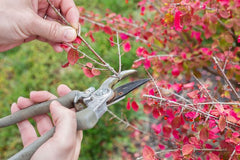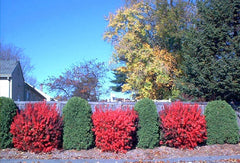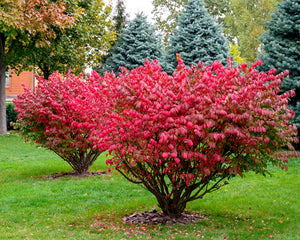The Burning Bush, also called the Euonymus alatus, and the winged euonymus, is one of the most colorful shrubs out there. A brilliant, fire-red illuminates off the shrub, catching everyone’s eye. The best part about this shrub is the colorful display that will last for months! Not only does the shrub have great fall color but in the spring and summer it is covered in a beautiful shade of green. While the color adds great appeal to the Burning Bush plant, there are many other attractive qualities. This no maintenance, no headache shrub is easy to grow and extremely hardy. The Burning Bush is a fast-growing shrub. You could use the Burning Bush in a variety of ways, making it easy to place in any landscape. Be warned that it is sure to steal attention from all others around it and make your yard the talk of the neighborhood. Learn some tips and tricks for burning bush pruning, care, and more.
Sunlight Requirements
The Burning Bush grows best in partial shade to full sun. It develops and comes into its well-known bright red color when planted and grown in full sunlight. It can however, become very red in areas that receive a few hours of shade each day. This brilliant shrub does very well in areas with a strong hot sun, followed by light, shade in the afternoon. While the Burning Bushes do well in the shade, extended periods of shade will interfere with the beautiful fall color that is anticipated. A more faded reddish pink could be the result of too much shade. Though a pretty color, it does not have the same effect as the bright red hue it is famous for.
Soil Requirements
The Burning Bush is a very highly adaptable shrub. You can plant it in a variety of soils without any problems or concerns. It prefers a well-drained soil. The PH levels of the soil have no effect on how the Burning Bush grows. This shrub has the ability to grow in all soil PH levels but they do tend to favor acidic soil with PH levels of 6.0-6.5.
Watering Requirements
Once established, the Burning Bush has a great drought tolerance, requiring little watering. It also has a strong tolerance for a variety of climates. Homeowners all over the country will have no problem growing the Burning Bush.
Burning Bush Pruning

As stated above, the Burning Bush is a no maintenance required shrub. However, like anything, it does require a little TLC.
When to prune burning bushes. Pruning your Burning Bush in late winter/early spring will help it stay healthy and looking good. If you neglect to do so, it could lead to more work down the road.
How to Prune Burning Bushes
There are 4 pruning stages your Burning Bush could require.
-
Light Pruning
Light pruning is just a matter of maintaining the shape of the Burning Bush. This can be done at any time during the year. Cutting overgrown branches back to the form of the bush during the summer helps to keep it in shape. We suggest cutting branches at a 45’ angle, this allows water to run off easily.
-
Routine Pruning
Routine pruning takes place before new growth, usually done in late winter or early spring. During this time you remove dead or diseased wood. Removing the dead or diseased wood close to the main branch or pruning dead plant parts helps to make a healthy bud, allowing healthy wood to grow. In essence, this creates a healthy Burning Bush. Routine pruning (done annually) helps to prevent serious problems which will require more time and care.
-
Heavy Pruning
When your Burning Bush has been neglected (usually when routine pruning does not occur) it requires a more invasive pruning process in order to be rejuvenated. Heavy pruning needs to be done in late winter or early spring before new growth. What you will need to do is cut 1/3 of the new canes growing from around the base of the Burning Bush to the ground level. This must be done with a pruning saw or pruning shears. This opens the center of the shrub, letting light in and improves air circulation. At the same time you are also controlling the size and density of the shrub.
-
Severe Pruning
This occurs when the Burning Bush has been drastically neglected. Typically, at this point, the shrub is overgrown or sickly. With a saw you must cut the entire Burning Bush to ground level in early spring. This gives new growth plenty of growing time.
Burning Bush Landscaping Ideas
 Need Burning Bush landscaping ideas? The Burning Bush is one of those shrubs that could be used in a variety of ways. Its adaptability, size and tolerance make this plant even more incredible. The attention grabbing, Burning Bush could go anywhere in your landscape and serve any purpose. The Burning Bush is great for foundation plants, privacy hedges, borders, entryways, mass planting and even formal planting.
Need Burning Bush landscaping ideas? The Burning Bush is one of those shrubs that could be used in a variety of ways. Its adaptability, size and tolerance make this plant even more incredible. The attention grabbing, Burning Bush could go anywhere in your landscape and serve any purpose. The Burning Bush is great for foundation plants, privacy hedges, borders, entryways, mass planting and even formal planting.
Burning Bushes make great borders and hedges for both small and large properties. We suggest you plant these bushes 5-6 ft. apart if you choose them for your border. Plant several Burning Bushes 1 foot apart to create a hedge. These colorful shrubs makes a great hedge plant. They are very dense and grow into neat, compact hedges that require very little maintenance.The naturally round shape of the Burning Bush makes it a great choice as a focal point in your yard. The bright red beauty does not need to be surrounded by other plants in order to turn heads. It is a perfect specimen plant. The Burning Bush will turn your once mediocre yard into the talk of the neighborhood. The Burning Bush could also be placed in the center of your garden. Surround it with flowers with equally beautiful fall color.
 Due to their incredible adaptability and tolerance for weather conditions and pollution, the Burning Bush is great for urban areas. Issues that sometimes inhibit other plants are no problem for the this tough shrub. It is the perfect choice for anyone, anywhere.
Due to their incredible adaptability and tolerance for weather conditions and pollution, the Burning Bush is great for urban areas. Issues that sometimes inhibit other plants are no problem for the this tough shrub. It is the perfect choice for anyone, anywhere.
If you’re thinking of adding more plants to your yard, it is important to choose ones that pair well with the Burning Bush. The Burning Bush has such a dynamic red color that it over powers most plants. However, there are plants that when paired with the Burning Bush shrub will complement each other well.
Evergreens, woody trees and a few colorful trees all mix well with the Burning Bush. Evergreens are a perfect match for the Burning Bush. They provide the right contrasting background that will make the bright red of the Burning Bush pop! Evergreens are tall, pyramid like, with dark green feathery needles. They pair well with the Burning Bush which is upright, compact and round with smooth red leaves. When the leaves of the Burning Bush start to shed, the beautiful evergreen will provide a great backdrop for the bare branches. We suggest the Deodora Cedar, Japanese Cryptomeria or the Douglas Fir as suitable evergreens. The Crape Myrtle and River Birch pair well to create a forest like vibe for your landscape. These woody trees provide a peeling look, have flaking bark or multi stemmed trunks. These features mixed with the Burning Bush makes for a great combination.
Check out our Evergreen Trees and Shade Trees for complementary options!
 Now, to add more color to your landscape, pick trees with primary colors that only enhance the beauty of this shrub. The Burning Bush is a fall delight. Therefore, adding other fall colors will look amazing! Trees with yellow such as the Ginkgo, Quaking Aspen or the Witch Hazel will provide such a contrast leaving people breathless. There are also trees such as the Sugar Maple and Sassafras that have a yellow to orange color to their leaves. These colors will go perfect with the Burning Bush. Perhaps you want to go one step further and bring in more red or a purplish color. The Japanese Maple is a great choice. However, do not be overbearing with these trees. You do not want to take away from or clash with the Burning Bush.
Now, to add more color to your landscape, pick trees with primary colors that only enhance the beauty of this shrub. The Burning Bush is a fall delight. Therefore, adding other fall colors will look amazing! Trees with yellow such as the Ginkgo, Quaking Aspen or the Witch Hazel will provide such a contrast leaving people breathless. There are also trees such as the Sugar Maple and Sassafras that have a yellow to orange color to their leaves. These colors will go perfect with the Burning Bush. Perhaps you want to go one step further and bring in more red or a purplish color. The Japanese Maple is a great choice. However, do not be overbearing with these trees. You do not want to take away from or clash with the Burning Bush.
Browse our online plant nursery for the largest selection available.


 As stated above, the Burning Bush is a no maintenance required shrub. However, like anything, it does require a little TLC. When to prune burning bushes. Pruning your Burning Bush in late winter/early spring will help it stay healthy and looking good. If you neglect to do so, it could lead to more work down the road.
As stated above, the Burning Bush is a no maintenance required shrub. However, like anything, it does require a little TLC. When to prune burning bushes. Pruning your Burning Bush in late winter/early spring will help it stay healthy and looking good. If you neglect to do so, it could lead to more work down the road.
 Need Burning Bush landscaping ideas? The Burning Bush is one of those shrubs that could be used in a variety of ways. Its adaptability, size and tolerance make this plant even more incredible. The attention grabbing, Burning Bush could go anywhere in your landscape and serve any purpose. The Burning Bush is great for foundation plants, privacy hedges, borders, entryways, mass planting and even formal planting.
Need Burning Bush landscaping ideas? The Burning Bush is one of those shrubs that could be used in a variety of ways. Its adaptability, size and tolerance make this plant even more incredible. The attention grabbing, Burning Bush could go anywhere in your landscape and serve any purpose. The Burning Bush is great for foundation plants, privacy hedges, borders, entryways, mass planting and even formal planting. Due to their incredible adaptability and tolerance for weather conditions and pollution, the Burning Bush is great for urban areas. Issues that sometimes inhibit other plants are no problem for the this tough shrub. It is the perfect choice for anyone, anywhere.
Due to their incredible adaptability and tolerance for weather conditions and pollution, the Burning Bush is great for urban areas. Issues that sometimes inhibit other plants are no problem for the this tough shrub. It is the perfect choice for anyone, anywhere. Now, to add more color to your landscape, pick trees with primary colors that only enhance the beauty of this shrub. The Burning Bush is a fall delight. Therefore, adding other fall colors will look amazing! Trees with yellow such as the Ginkgo, Quaking Aspen or the Witch Hazel will provide such a contrast leaving people breathless. There are also trees such as the Sugar Maple and Sassafras that have a yellow to orange color to their leaves. These colors will go perfect with the Burning Bush. Perhaps you want to go one step further and bring in more red or a purplish color. The Japanese Maple is a great choice. However, do not be overbearing with these trees. You do not want to take away from or clash with the Burning Bush.
Now, to add more color to your landscape, pick trees with primary colors that only enhance the beauty of this shrub. The Burning Bush is a fall delight. Therefore, adding other fall colors will look amazing! Trees with yellow such as the Ginkgo, Quaking Aspen or the Witch Hazel will provide such a contrast leaving people breathless. There are also trees such as the Sugar Maple and Sassafras that have a yellow to orange color to their leaves. These colors will go perfect with the Burning Bush. Perhaps you want to go one step further and bring in more red or a purplish color. The Japanese Maple is a great choice. However, do not be overbearing with these trees. You do not want to take away from or clash with the Burning Bush.